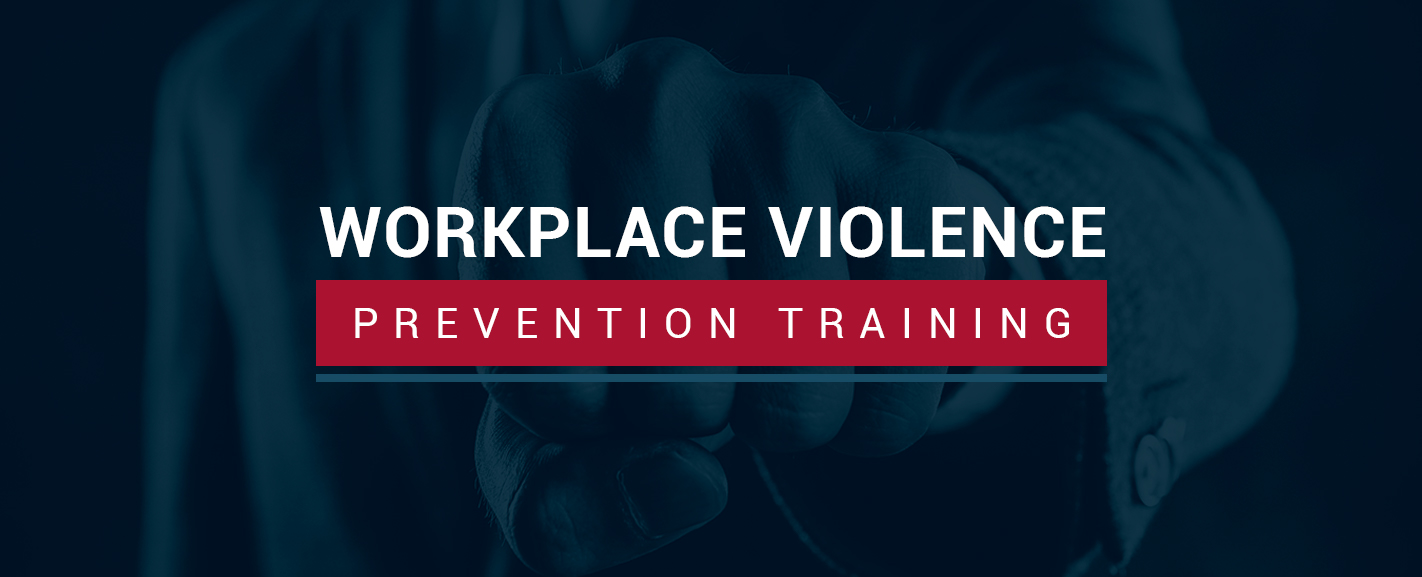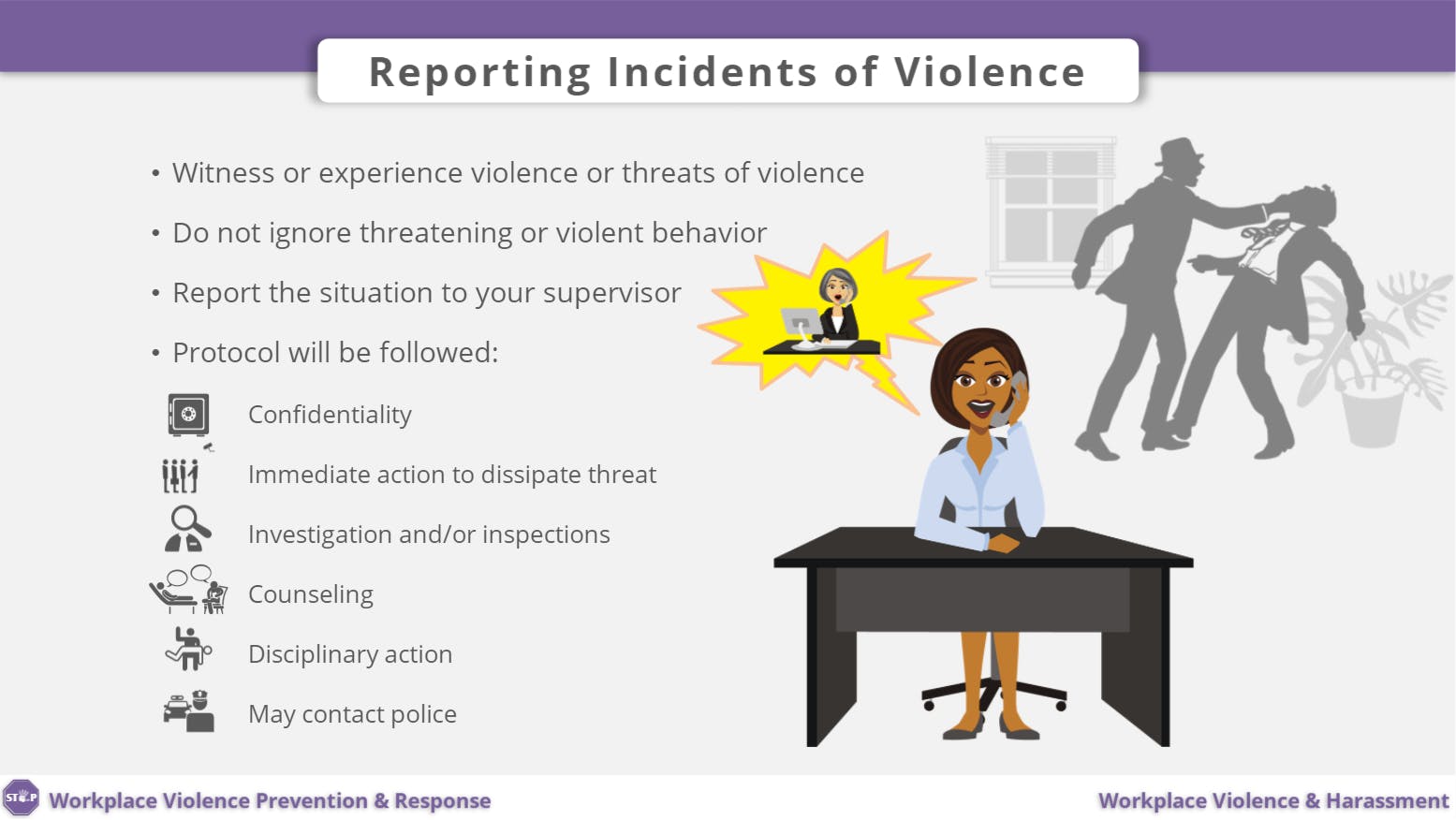Vital Standards for California Workplace Violence Prevention: A Comprehensive Approach
Vital Standards for California Workplace Violence Prevention: A Comprehensive Approach
Blog Article
The Function of Employee Training and Recognition in Enhancing Workplace Physical Violence Avoidance Initiatives Throughout Various Industries
The assimilation of employee training and recognition into office violence prevention campaigns is progressively acknowledged as a basic element of business safety throughout diverse markets. By executing targeted training programs, companies can properly empower their workforce to recognize and address possible risks before they escalate. Nonetheless, the effectiveness of these efforts frequently depends upon numerous crucial aspects that differ by sector, increasing crucial inquiries concerning the flexibility of training methods and their real-world impact. Understanding these subtleties might disclose techniques that can significantly enhance safety procedures and worker self-confidence in risky atmospheres.
Significance of Training Programs
In today's vibrant workplace, the relevance of training programs can not be overemphasized, especially in the context of workplace violence prevention. These programs function as a foundational element in growing a secure and protected workplace society. By furnishing workers with the knowledge and skills essential to determine, mitigate, and react to potential hazards, organizations can foster an environment that focuses on safety and health.
Efficient training programs do more than just instruct; they empower workers to acknowledge indication of physical violence, comprehend the protocols for reporting cases, and create strategies to de-escalate prospective problems. In addition, they instill a feeling of cumulative obligation among staff, urging proactive involvement in keeping a safe work environment.
Financial investment in training not only improves staff member awareness however likewise shows an organization's commitment to securing its labor force. This proactive technique can lead to minimized occurrences of office violence, lower absenteeism, and enhanced worker spirits. Eventually, detailed training programs are essential to establishing a resilient business culture that values safety and security and promotes a healthy and balanced workplace, thus minimizing the danger of physical violence and its connected effects.
Key Components of Effective Recognition
A thorough recognition program includes several key parts that are essential for properly protecting against office physical violence. First, clear communication of treatments and plans related to work environment violence is vital. Employees have to be notified about the company's stance on physical violence and the certain protocols in location for reporting incidents.
2nd, training sessions ought to include sensible scenarios that staff members may run into. This functional method aids workers identify cautioning indicators of prospective physical violence and equips them with the necessary abilities to de-escalate tense scenarios. Third, promoting a supportive work environment culture is crucial; workers ought to really feel empowered to speak out without worry of retaliation.
In addition, ongoing education and learning is very important to keep understanding fresh and relevant. Normal correspondence course and updates on arising dangers can improve workers' caution and readiness. Lastly, including feedback systems permits employees to share their insights and experiences, which can cause continual improvement of understanding efforts. By incorporating these parts, organizations can produce a robust framework for preventing workplace violence, eventually contributing to a much safer and a lot more efficient atmosphere for all workers.
Industry-Specific Training Methods
Effective office physical violence prevention training must be customized to the special difficulties and risks encountered by specific industries. As an example, health care environments call for training that attends to the high possibility of experiences with hostile individuals or visitors. Programs need to concentrate on de-escalation techniques, identifying indication of prospective violence, and ensuring staff understand the significance of reporting cases.
In contrast, retail setups may encounter different threats, such as robbery or consumer disputes. Training in these settings should highlight situational awareness, feedback procedures throughout emergency situations, and the significance of safeguarding cash and prized possessions.
Manufacturing and building sectors present their very own dangers, frequently connected with interpersonal disputes or harmful working conditions. Training in these markets should include methods for problem resolution, promoting a culture of security, and urging open communication among workers.
Additionally, company workplaces may call for training fixated avoiding harassment and bullying, fostering a considerate work environment society, and implementing clear reporting systems. Each sector has to not only recognize its particular vulnerabilities however likewise adjust training materials to resonate with the workforce efficiently, guaranteeing that workers really feel equipped and equipped to manage possible terrible situations.
Gauging Educating Performance
Examining the effect of office violence avoidance training is vital for making sure that staff members are appropriately prepared to deal with potential hazards. Pre- and post-training surveys can gauge changes in worker knowledge, perspectives, and habits concerning workplace violence.
In addition, useful assessments, such as read what he said role-playing circumstances or simulations, can give insights into exactly how well workers apply found out skills in real-life situations. Keeping track of case records before and after training can likewise serve as an indicator of efficiency, as a decrease in cases may reflect enhanced staff member view readiness.
Additionally, comments from participants should be systematically collected to determine locations for improvement in training web content and shipment. Conducting follow-up analyses at routine intervals aids endure understanding and enhances training principles in time - california workplace violence prevention. By employing a thorough method to measuring training efficiency, organizations can make sure that their office violence prevention campaigns cultivate a much safer atmosphere and boost general employee health
Building a Culture of Security

Training plays a critical function in this social change. Normal, comprehensive training sessions educate employees about acknowledging caution indications of work environment physical violence and the proper responses. Additionally, motivating open interaction allows workers to voice issues without concern of vengeance, advertising cumulative responsibility for safety and security.
Furthermore, integrating security into daily procedures ensures that it comes to be a common worth instead of a simple compliance problem. This includes regular security drills, updates on policies, and feedback devices that entail workers in security discussions and improvements.
Ultimately, a durable culture of safety not just minimizes the dangers of workplace physical violence however additionally boosts employee spirits and efficiency. By fostering a setting where security is a fundamental top priority, organizations can develop durable workplaces that sustain both private health and cumulative success.
Verdict
In conclusion, employee training and try this site awareness are essential parts in the avoidance of work environment violence throughout different industries. Efficient training programs, tailored to specific market requirements, enhance workers' capability to recognize and respond to possible threats.

Routine, thorough training sessions enlighten employees regarding identifying warning indications of workplace violence and the ideal feedbacks.In conclusion, staff member training and recognition are crucial elements in the prevention of office violence across numerous markets.
Report this page